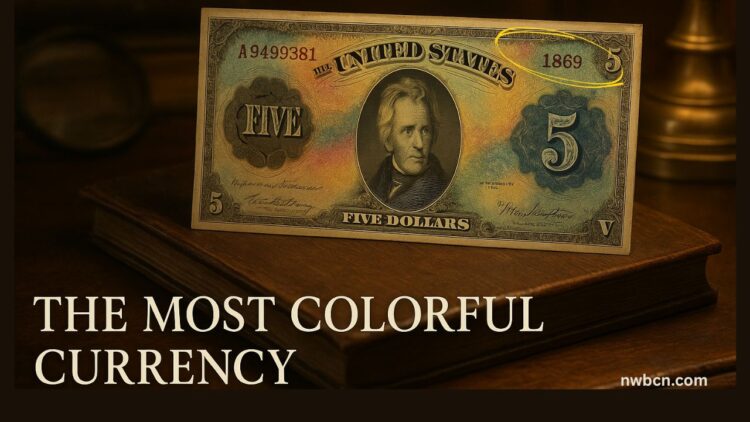The 1869 “Rainbow Note” $5 bill, officially designated Series of 1869 Legal Tender Note FR‑64, stands as the most visually stunning piece of American currency ever printed.
With its vibrant hues and iconic imagery, this large-size $5 note captivates collectors and historians alike. Let’s dive into the fascinating history, design, rarity, values, and legacy of this colorful masterpiece.
A Revolutionary Design: Why It’s Called the “Rainbow Note”
The 1869 Series introduced bold anti-counterfeiting features never before seen in U.S. currency. Most notably:
Red Treasury seal and red serial numbers
A vertically-applied light blue tint covering one-third of the note
A subtle green frame surrounding serial numbers
Together, these three colors—red, green, and blue—gave the note its vivid, rainbow-inspired appearance, earning it the nickname “Rainbow Note.”
Iconic Imagery: The Woodchopper and Andrew Jackson
The obverse features two captivating scenes:
On the left, a stern portrait of President Andrew Jackson, engraved by Alfred Sealey and based on artwork by Thomas Sully
In the center, the legendary Woodchopper or Pioneer Family vignette—an ax-wielding frontiersman with his wife, child, and dog—engraved by Henry Gugler
This dynamic contrast between presidential gravitas and frontier life creates a narrative of American identity: leadership and the pioneering spirit.
Specifications and Signatures
Here’s a breakdown of its key attributes:
| Feature | Detail |
|---|---|
| Series | 1869 Legal Tender Note, FR‑64 |
| Denomination | $5 USD |
| Size | Large size – approx. 189 × 79 mm |
| Obverse Engravers | Andrew Jackson (Sealey/Sully), Pioneer Family (Gugler) |
| Seal & Serial | Large red Treasury seal; red serials with green framing |
| Blue Tint | Vertical blue-tinted paper for security |
| Signatories | Register John Allison; Treasurer James Nelson Huston |
| Printing Act | Act of March 3, 1863; patented 1863/1866 |
Rarity and How Many Exist
With approximately 600–1,000 specimens known, the Series 1869 $5 “Rainbow Note” is significantly scarcer than its $1 and $2 counterparts. Over time, many have been lost, destroyed, or recycled, making high-grade survivors even more prized.
Grading and Auction Values
Here’s a snapshot of recent market values based on condition:
- Choice Very Fine (VF-25 to VF-35): $2,000–$4,000
- About Uncirculated (AU-55 to AU-58): $4,000–$6,000
- Gem Uncirculated (PMG/PCGS 62–66): $8,000–$26,000
A few standout examples include:
- PMG 64 EPQ selling around $7,500
- PCGS Gem 66 PPQ fetching $17,000
- The ultra-high end PMG 66 EPQ listed at $26,400
Noteworthy Auction and Sale Mentions
- A CU-62 Signature pair (Allison/Spinner) piece sold in April 2025 for between $3,400–$6,800
- A PMG 62 PPQ note listed by a major dealer at $3,950–$4,000
- A PCGS 58 note priced around $4,850
These sales underscore the consistent collector demand and impressive price variations tied to condition.
Why Collectors Treasure the Rainbow Note
- Visual drama: The captivating tricolor palette makes it arguably the most beautiful US banknote
- Historical innovation: A major leap forward in anti-counterfeiting design
- Narrative richness: Melding presidential history, pioneering imagery, and legislative context
- Rarity and scarcity: With few surviving specimens in top grade, it’s a rare gem
- Growing market: Strong recent auction performance affirms enduring investor interest
Care and Authentication Tips
Collectors should look for:
- Accurate coloration: Genuine red/green/blue tones, not modern dye
- Sharp, original paper: No repairs, no modern bright white
- Confirmation of signatory pairing: Allison/Huston original to 1869
- Grading verification: Reputable certification (PMG/PCGS) for assurance
For serious preservation, UV and light protection are essential to prevent the hues from fading.
Masterpiece of American Currency
The 1869 “Rainbow Note” $5 bill represents a rare confluence of technological innovation, eye-catching aesthetics, and historical resonance.
From its unique visual palette to its frontier imagery, it is more than just currency—it is a vivid artifact of post-Civil War America.
The 1869 Rainbow Note $5 bill is without question America’s most colorful and collectible currency. Born out of a drive to prevent counterfeiting and capture the adventurous post-Civil War mood, this large-size note remains a show-stopper in any collection.
Its bold design, patriotic imagery, scarce surviving condition, and strong market demand combine to make it an enduring symbol of numismatic excellence.
Frequently Asked Questions
1. What makes the 1869 $5 “Rainbow Note” so rare and valuable?
Only around 600–1,000 examples are known, with even fewer surviving in high grades. Its vibrant multi-color printing and historical anti-counterfeiting measures cement its legacy and desirability among collectors.
2. What condition should a collector look for when buying one?
Aim for AU (About Uncirculated, 55–58) or higher for the best eye appeal and investment value. Gem uncirculated examples (PMG/PCGS 62–66) command the highest prices, often above $10,000.
3. How can I be sure a “Rainbow Note” is authentic?
Check for the correct red seal, red serials, blue vertical tint, and green framing. Authentication by trusted services like PMG or PCGS, along with historical signatories and paper quality, increases confidence in its authenticity.
